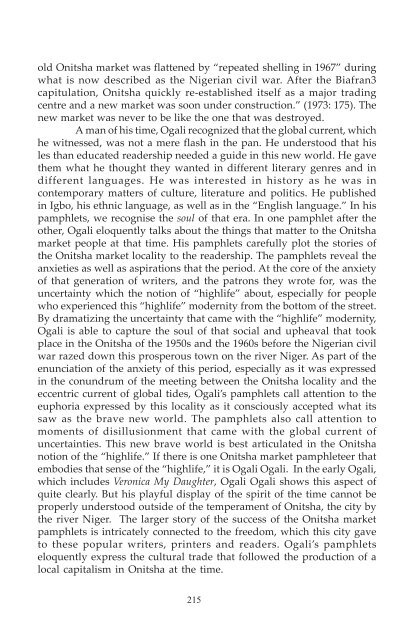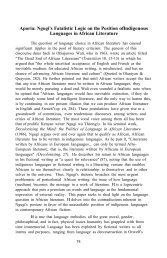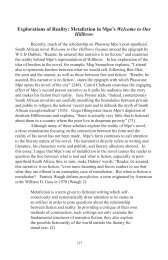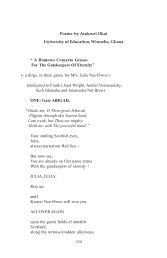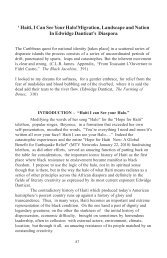JALA Winter-Spring 2008-Vol 2 No 1 - African Literature Association
JALA Winter-Spring 2008-Vol 2 No 1 - African Literature Association
JALA Winter-Spring 2008-Vol 2 No 1 - African Literature Association
You also want an ePaper? Increase the reach of your titles
YUMPU automatically turns print PDFs into web optimized ePapers that Google loves.
old Onitsha market was flattened by “repeated shelling in 1967” during<br />
what is now described as the Nigerian civil war. After the Biafran3<br />
capitulation, Onitsha quickly re-established itself as a major trading<br />
centre and a new market was soon under construction.” (1973: 175). The<br />
new market was never to be like the one that was destroyed.<br />
A man of his time, Ogali recognized that the global current, which<br />
he witnessed, was not a mere flash in the pan. He understood that his<br />
les than educated readership needed a guide in this new world. He gave<br />
them what he thought they wanted in different literary genres and in<br />
different languages. He was interested in history as he was in<br />
contemporary matters of culture, literature and politics. He published<br />
in Igbo, his ethnic language, as well as in the “English language.” In his<br />
pamphlets, we recognise the soul of that era. In one pamphlet after the<br />
other, Ogali eloquently talks about the things that matter to the Onitsha<br />
market people at that time. His pamphlets carefully plot the stories of<br />
the Onitsha market locality to the readership. The pamphlets reveal the<br />
anxieties as well as aspirations that the period. At the core of the anxiety<br />
of that generation of writers, and the patrons they wrote for, was the<br />
uncertainty which the notion of “highlife” about, especially for people<br />
who experienced this “highlife” modernity from the bottom of the street.<br />
By dramatizing the uncertainty that came with the “highlife” modernity,<br />
Ogali is able to capture the soul of that social and upheaval that took<br />
place in the Onitsha of the 1950s and the 1960s before the Nigerian civil<br />
war razed down this prosperous town on the river Niger. As part of the<br />
enunciation of the anxiety of this period, especially as it was expressed<br />
in the conundrum of the meeting between the Onitsha locality and the<br />
eccentric current of global tides, Ogali’s pamphlets call attention to the<br />
euphoria expressed by this locality as it consciously accepted what its<br />
saw as the brave new world. The pamphlets also call attention to<br />
moments of disillusionment that came with the global current of<br />
uncertainties. This new brave world is best articulated in the Onitsha<br />
notion of the “highlife.” If there is one Onitsha market pamphleteer that<br />
embodies that sense of the “highlife,” it is Ogali Ogali. In the early Ogali,<br />
which includes Veronica My Daughter, Ogali Ogali shows this aspect of<br />
quite clearly. But his playful display of the spirit of the time cannot be<br />
properly understood outside of the temperament of Onitsha, the city by<br />
the river Niger. The larger story of the success of the Onitsha market<br />
pamphlets is intricately connected to the freedom, which this city gave<br />
to these popular writers, printers and readers. Ogali’s pamphlets<br />
eloquently express the cultural trade that followed the production of a<br />
local capitalism in Onitsha at the time.<br />
215


